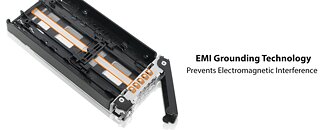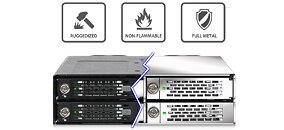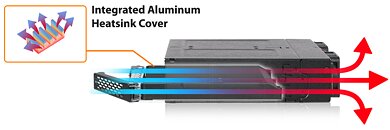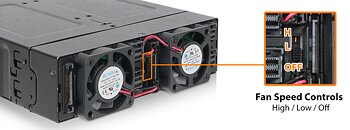Monday, February 10th 2020
ICY DOCK Introduces ToughArmor MB720M2K-B Full Metal 4 Bay for M.2 NVMe SSDs
Introducing the ToughArmor MB720M2K-B, the world's first quad drive ruggedized M.2 NVMe SSD removable enclosure. M.2 NVMe SSDs no longer requires to be installed on to a motherboard or a riser card with a tiny screw and can now be installed and accessed from the front of your computer without any tools. The ToughArmor MB720M2K-B comes with patent-pending tool-less M.2 drive installation design which will alleviate the pain that many user experiences when installing M.2 drives and offer easy drive maintenance and system upgrading.The ToughArmor MB720M2K-B supports up to 4x M.2 PCIe NVMe SSD with blazing fast PCIe x4 transfer speed up to 32 Gb/s per channel via MiniSAS HD (SFF-8643). It also accepts all standard M.2 drives lengths from 30 mm to 110 mm (2230, 2242, 2260, 2280, 22110). In addition, while working together with numbers of ventilation holes around the enclosure, each drive tray is equipped with a high efficiency aluminium heat sink to ensure all the M.2 NVMe SSDs remain within optimal temperatures even when it is under full load. Ultimately, your drives will be well protected within this full metal drive enclosure and a barrel key lock to prevent any unauthorized physical access.
M.2 PCIe NVMe SSD drives are most often inserted at a 45-degree angle then screwed down onto the motherboard. When using ToughArmor MB720M2K-B, the user can simply place M.2 SSD in the drive tray, adjust the drive locker to the correct length per M.2 drive type, and push down the drive to lock in place. The whole process will only take users less than five seconds to complete, avoiding the hassle of dealing with tiny easy-to-lose screws while bringing a more efficient and innovative way in installing M.2 drives.
Full Drive Length Support
This innovative adjustable M.2 locker slider accommodates all standard M.2 PCIe NVMe SSD drive lengths including 2230 (30 mm), 2242 (42 mm), 2260 (60 mm), and 22110 (110 mm), making this drive tray universal to all drive lengths and future-proofing the extra-long M.2 drive 22110 (110 mm).
EMI Grounding Technology
Grounding your M.2 is very important through many swaps, to ensure your data and drive are always safe. Without grounding, when swapping drives, there is a high possibility that there may be static shocks, possibly damaging the data on the drive. With our innovative M.2 drive installation design, the adjustable M.2 locker act as a ground and once the M.2 locker clips into the SSD screw hole, the drive will be grounded by the tray and the housing of the enclosure. The grounded connector design protects your drive from static electrical surge, ensuring your data is always safe during drive swapping.Superior Performance
To fully use the speeds of NVMe M.2 SSD, each drive uses its own miniSAS HD (SFF-8643) connector, maximizing the NVMe M.2 SSD's potential transfer bandwidth rate of 32 Gb/s in each drive, which is over 5 times faster than previous SATA standard, making it an ideal solution for data intensive application such as in real-time servers, high performance PCs, deep-learning machines and 4k/8k/3D media workstations.
ToughArmor Protection
Ensuring the product can be relied upon for many years after its deployment, the ToughArmor MB720M2K-B is capable of holding up in the harshest environments, with a rugged heavy duty metal construction throughout the entire device. The ToughArmor MB720M2K-B full metal design is perfect for industrial devices that may require a flammability rating since all-metal already complies with flammability requirements. Because of the high build quality, it can be used in various enterprise systems including: military and law enforcement deployment along with manufacturing conditions such as embedded control and factory automation systems.Maximum Cooling Performance
M.2 NVMe SSDs are notorious for their overheating issue, which results in performance degradation and transfer speed throttling. We understand this issue and came fully equipped with an extra-large high-efficiency aluminium heatsink installed onto every ToughArmor MB720M2K-B's tray. Additionally, each ToughArmor MB720M2K-B includes a pair of thermal heat pads to ensure that excessive heat is dispersed thoroughly throughout the entire heatsink.Working together with dual 40 mm ball-bearing cooling fans,the heat is further dispersed through the intelligently placed ventilation holes. Each fan has three fan speed settings: high, low and off. The user can manually select the proper cooing option to keep the drive stays at optimal operating temperatures even under full load.
Packed with Features
An LED status light built into the tray lets you know your drive is powered up and in use. To save power, the LED is shut off when no drive is installed.
Never forget which drives belong in what bays. With our individual drive ID labels, you'll always know which drive tray belongs in your RAID array or which drives contains certain files. Freely unplug and rearrange them to better suit your configurations or simply remove them for a simplified look. The ToughArmor MB720M2K-B supports 15 pin SATA power cables with locking latches, so you'll never need to worry about cables unintentionally disconnecting from your enclosure. Once these cables are connected, they will lock and stay in place.
Key Features
M.2 PCIe NVMe SSD drives are most often inserted at a 45-degree angle then screwed down onto the motherboard. When using ToughArmor MB720M2K-B, the user can simply place M.2 SSD in the drive tray, adjust the drive locker to the correct length per M.2 drive type, and push down the drive to lock in place. The whole process will only take users less than five seconds to complete, avoiding the hassle of dealing with tiny easy-to-lose screws while bringing a more efficient and innovative way in installing M.2 drives.
Full Drive Length Support
This innovative adjustable M.2 locker slider accommodates all standard M.2 PCIe NVMe SSD drive lengths including 2230 (30 mm), 2242 (42 mm), 2260 (60 mm), and 22110 (110 mm), making this drive tray universal to all drive lengths and future-proofing the extra-long M.2 drive 22110 (110 mm).
EMI Grounding Technology
Grounding your M.2 is very important through many swaps, to ensure your data and drive are always safe. Without grounding, when swapping drives, there is a high possibility that there may be static shocks, possibly damaging the data on the drive. With our innovative M.2 drive installation design, the adjustable M.2 locker act as a ground and once the M.2 locker clips into the SSD screw hole, the drive will be grounded by the tray and the housing of the enclosure. The grounded connector design protects your drive from static electrical surge, ensuring your data is always safe during drive swapping.Superior Performance
To fully use the speeds of NVMe M.2 SSD, each drive uses its own miniSAS HD (SFF-8643) connector, maximizing the NVMe M.2 SSD's potential transfer bandwidth rate of 32 Gb/s in each drive, which is over 5 times faster than previous SATA standard, making it an ideal solution for data intensive application such as in real-time servers, high performance PCs, deep-learning machines and 4k/8k/3D media workstations.
ToughArmor Protection
Ensuring the product can be relied upon for many years after its deployment, the ToughArmor MB720M2K-B is capable of holding up in the harshest environments, with a rugged heavy duty metal construction throughout the entire device. The ToughArmor MB720M2K-B full metal design is perfect for industrial devices that may require a flammability rating since all-metal already complies with flammability requirements. Because of the high build quality, it can be used in various enterprise systems including: military and law enforcement deployment along with manufacturing conditions such as embedded control and factory automation systems.Maximum Cooling Performance
M.2 NVMe SSDs are notorious for their overheating issue, which results in performance degradation and transfer speed throttling. We understand this issue and came fully equipped with an extra-large high-efficiency aluminium heatsink installed onto every ToughArmor MB720M2K-B's tray. Additionally, each ToughArmor MB720M2K-B includes a pair of thermal heat pads to ensure that excessive heat is dispersed thoroughly throughout the entire heatsink.Working together with dual 40 mm ball-bearing cooling fans,the heat is further dispersed through the intelligently placed ventilation holes. Each fan has three fan speed settings: high, low and off. The user can manually select the proper cooing option to keep the drive stays at optimal operating temperatures even under full load.
Packed with Features
An LED status light built into the tray lets you know your drive is powered up and in use. To save power, the LED is shut off when no drive is installed.
Never forget which drives belong in what bays. With our individual drive ID labels, you'll always know which drive tray belongs in your RAID array or which drives contains certain files. Freely unplug and rearrange them to better suit your configurations or simply remove them for a simplified look. The ToughArmor MB720M2K-B supports 15 pin SATA power cables with locking latches, so you'll never need to worry about cables unintentionally disconnecting from your enclosure. Once these cables are connected, they will lock and stay in place.
Key Features
- Fits 4x M.2 NVMe SSD of all lengths, 30 mm (2230), 42 mm (2242), 60 mm (2260), 80 mm (2280), and 110 mm (22110).
- Adjustable drive locker holds all length drives securely
- Tool-less drive installation design for easy drive maintenance and system upgrading
- Installs into any standard external 5.25" device bay
- Uses 4x miniSAS HD (SFF-8643) to connect, requires NVMe host
- Supports the full NVMe bandwidth specification of 32 Gbps per channel
- Ruggedized full-metal enclosure meeting flammability requirements
- Integrated extra-large high-efficiency heat sink and ample ventilation for excellent passive cooling
- 2-segment key lock for additional physical security
- Eagle-hook tray latch securely holds the tray inside the enclosure
- EMI Grounding - protects hard drives from electrical damage
- Anti-Vibration Technology (AVT) reduces noise and protects against environmental damage
- Industry leading 3-year warranty against all defects
- Complimentary support from professionally trained US-based technical support agents






16 Comments on ICY DOCK Introduces ToughArmor MB720M2K-B Full Metal 4 Bay for M.2 NVMe SSDs
Now if it has a reasonable price and will support raid (it hints at this), they will probably sell a lot of these :)
The only negative thing is where are the data cables? I found the page on Icy Dock's website and didn't see any cables mentioned or included. I found a listing on Newegg (third party seller) and it's a bit expensive though when you need to swap drives with minimal down time it's worth it. In the very least they should recommend some cables...
My Define XL R2 still has 4 5.25" slots :D
But I mean, you gotta have that Anti-Vibration Technology. After all it's not like these are solid-state drives... oh wait.
If each disk connects using PCIe X2, then the number of required PCI lines would be 2 X 4 X 4 = 32. You would need a Ryzen 3000 series CPU and X570 motherboard to connect this many NVMe disks.
You will have nothing left to connect to the motherboard except a PCIe X8 GPU, if you need network connection too, then you might need to downgrade to a PCIe X4 GPU...
So, you would be running exclusively on AMD 3000 series CPU's and an integrated graphic card level video card, but man, that would be a properly-designed product ...
Don't get me wrong, this is not a knock on you, I hate the low PCI lane counts and the artificial limitations imposed by them where we can't use some PCI slots on our motherboards.
Not even the simple calculation is possible as there are limitations on PCIe lane allocation rules, even on AMD's latest and greatest as shown in the X570 platform diagram: www.guru3d.com/articles_pages/amd_ryzen_5_3600_review,4.html
"X570 PCH actually includes sixteen PCIe lanes, in addition to the 24 PCIe lanes on the CPU, with a total of 4 (four) 4-lane physical interfaces (4x PCIe 4.0 x4 PHY), fully configurable in PCIe x16, x8, x4, x2, x1, and SATA modes. The X570 chipset offers 8x USB 3.2 Gen 2, 4x USB 2.0, 4x SATA and 8 separate PCI-Express 4.0 lanes. That leaves eight flexible lanes that can be used for PCI-Express and SATA. As you can see, the flexible design allows motherboard manufacturers lots of options in what they want to offer. When you think about it, an AMD X570 motherboard could even get four M.2 slots for PCI-Express 4.0 x4 SSDs. Please do keep in mind that only Ryzen 3000 (Zen2) will open up X570 to the CPU at PCIe 4.0 x4. If a Ryzen 3000 family proc is used or, say, an APU based on older architecture, the chipset connection will become PCIe 3.0. In the end, the X570 platform will be AMD's most advanced offering ever. It is leading over what Intel offers. "
If reports are to be believed, Intel will not give us more than 16 PCI lanes in next 2 years ...
I'm not suggesting having 16 disks. I'm suggesting that instead of an unnecessarily large 5.25" device that can fit 4 NVMe drives, you shrink it down to a 3.5" device that can fit 4 NVMe drives.
Either way though, this device isn't likely to be used in any application except HEDT workstations due to the use of SFF-8643. There are almost no motherboards with those ports, and expansion cards that have them are not cheap (they're generally also RAID cards which is where most of the expense comes from - this looks promising but no idea where to buy). If you aren't willing or able to fork out for that then you need four of either variant of these, which either consume PCIe slots or NVMe slots.